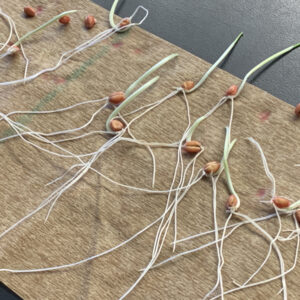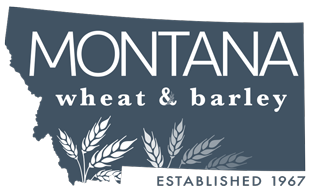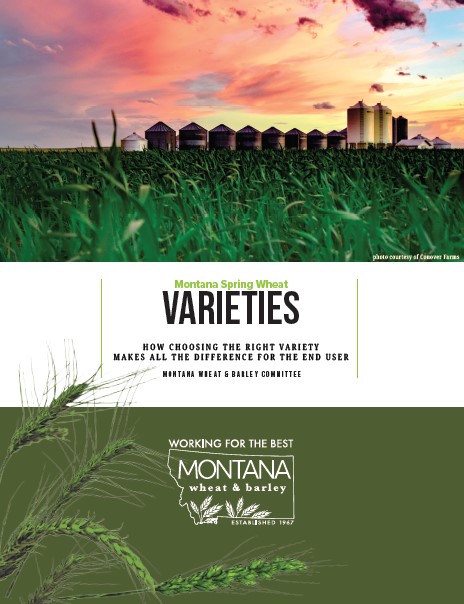Varieties
The plant breeding program at Montana State University is an essential part of agriculture for the state. Montana producers choose to plant varieties developed by the program because they are specifically adapted to Montana’s climate and several are resistant to common diseases and pest found statewide. In addition, the program is in contact with organizations and buyers from around the world collecting data on the needs of the end user.
Note the chart below which reviews some of Montana’s breeding priorities.

Take a look through our new Spring Wheat Varieties guide, hot off the press! Click on the cover image to read through the entire guide, including Montana spring wheat varieties currently in use by Montana producers, each WQI score tested at Montana State University’s Wheat Quality Lab, and testimonials by end users.
If you would like to receive a hard copy, email us: wbc@mt.gov
Choosing a modern, high yielding and disease resistant variety adapted to the growing environment is a crucial management decision. Each year, every breeding program screens around 2500 lines for evaluation. Over three stages of yield testing that take 4-5 years, lines are reduced from 100 to 30 to 10 to 5 to 1 or 2 with cultivar release potential.

Wheat Quality Council
Pacific Northwest Wheat Quality Council
MSU Cereal Quality Lab
MSU Malt Quality Lab
MSU Foundation Seed
Montana Seed Growers Association
MSU Schutter Diagnostic Lab
Montana Agriculture Research Stations
The Montana Wheat & Barley Committee partners with a multitude of entities to ensure best possible outcomes.


Our partners screen new lines to determine agronomic and end-use viability. This information helps guarantee that new releases will have excellent agronomic characteristics, as well as superior milling and baking qualities.
Northern is a hard red winter wheat developed by the Montana Agricultural Experiment Station and released to growers in fall 2015. Northern was named to commemorate the 100th anniversary of the Northern Agricultural Research Center (NARC) in Havre, Montana. Northern is derived from a cross between a Yellowstone sib line (MT9982) and hard white winter Montana (MTW0072) and Nebraska (NW97S151) experimental lines. Northern is a medium-late maturing, medium-short statured wheat, with white chaff. Northern has average yield (similar to Yellowstone and Colter, see Table 1), average test weight, and average protein (Table 2). Northern is resistant to both stem and stripe rust. Northern has above average milling and average baking properties
Bobcat: An awned, white-glumed, semi-dwarf wheat with medium to late maturity. Stem solidness is excellent with improved yield potential. Above average test weight, average protein, and average winter hardiness. Resistant to prevalent races of stripe and stem rust, but susceptible to leaf rust. Medium high PPO with above average milling and baking properties. Top performing in locations where sawfly cutting has occurred.
Flathead: A hollow-stemmed, medium height wheat with white chaff. Average yield, above average test weight, and average protein, with average winter survival. Out-yields other early maturing varieties. Flathead has excellent resistance to stripe rust and moderately resistant to both stem rust and dwarf bunt. Medium PPO with above average milling and baking characteristics.
Top Grown Varieties:
Warhorse is the most common winter wheat variety planted on 30.2 percent of Montana’s 2021 total winter wheat acres. Warhorse is a solid-stemmed hard red winter wheat released in 2013 by the Montana Agricultural Experiment Station. Warhorse has medium maturity and has medium short, semi-dwarf height. Warhorse yield is similar to Judee, while test weight and protein are above average. Warhorse is resistant to both stem and stripe rust. Warhorse has acceptable mill and bake qualities.
Yellowstone is the second most common winter wheat variety for 2021. It accounts for 9.5 percent of the state’s planted winter wheat acreage. Yellowstone is a hard red winter wheat developed by the Montana Agricultural Experiment Station and became available in 2005. The variety is high yielding with medium test weight, maturity, height, and protein. It has excellent baking and good noodle qualities. Yellowstone is moderately resistant to dwarf smut and stripe rust but is susceptible to stem rust.
Keldin ranks third in winter wheat acres for 2021 and accounts for 8.9 percent of planted winter wheat acreage. Keldin is a medium late, semi-dwarf hard red winter wheat. It has excellent yield and a strong stem. It also has good resistance to disease. It was developed by Pflanzenzucht Oberlimpurg of Germany and licensed to WestBred.
Judee is the fourth most common winter wheat variety planted in Montana. It accounts for 7.2 percent of the total winter wheat acreage in 2021. Judee is a white-glumed, semi-dwarf wheat that performs well in locations where sawfly cutting has occurred. Judee was developed by the Montana Agricultural Extension Station and released to growers in 2011. Judee is susceptible to prevalent races of leaf rust and stem rust, but resistant to stripe rust.
Brawl CL Plus is the fifth most common winter wheat variety planted on 6.4 percent of Montana’s total acres of winter wheat for 2021. Brawl CL Plus is a hard red winter wheat developed by the Colorado Agricultural Experiment Station released in 2011. It is tolerant of the Imazamox herbicide (Beyond), resistant to stripe rust, has high test weight and superior milling and bread baking qualities. It is suited for dryland and irrigated production in the west-central Great Plains.
NEW:
Lanning: A variety with high yield potential in dryland areas and superior end-use quality. Grain yield similar to Vida but with higher grain protein and stronger gluten characteristics. Lanning is hollow-stemmed, suggesting that it will be susceptible to damage caused by the wheat stem sawfly. Shown to have low-PH tolerance, performing well in acidic environments.
Dagmar: Designed to maintain the high grain yield conferred by the stay-green trait exhibited by Vida and Reeder. The stay-green trait is associated with high yield in dryland environments and lower gluten strength. Selection was for earlier heading date, while maintaining a long stay-green period. Maintains high yield while improving end-use quality by having senescence occur earlier.
Top Grown Varieties:
Vida is the leading spring wheat variety planted for 2021. Montana producers planted 22.6 percent of the State’s acres to Vida this year. Vida was derived from a cross of Scholar and Reeder in 1998 by the Montana Agricultural Experiment Station and released in 2005. It is a high yielding hard red spring with moderate resistance to leaf and stripe rust. Vida is a semi-dwarf with white glumes and awns, kernels are red ovate with rounded cheeks. Good milling and baking characteristics have made Vida a popular variety each year.
Reeder is the second most common spring wheat variety planted this year with 12.2 percent of the seeded acreage to spring wheat in Montana. Reeder was developed by the North Dakota Agricultural Experiment Station, released in 1999. It is an awned, semi-dwarf, hard red spring wheat. Reeder is resistant to upper Midwest stem and leaf rust. It was developed by crossing a relative of Stoa and germplasm from Brazil. Its stay-green trait allows for a longer head-filling period and in turn higher yield.
Lanning ranks as the third most common spring wheat variety planted for 2021 with 6.5 percent of planted acreage. Lanning was developed by Montana State University and released in 2016. Lanning has a high grain protein. It is a hollow-stemmed wheat with a high grain yield. This variety combines the traits of Glenn and MT0747. This variety also has a stay green trait for continued growth and increased yield.
SY Ingmar is the is the fourth most common spring wheat variety in Montana for 2021 with 5.9 percent of planted acreage. SY Ingmar was released by Syngenta/AgriPro in 2014 and has semi-dwarf height, strong straw strength, high grain protein, medium-maturity, and good milling and baking quality.
Corbin is the fifth most common spring wheat variety in 2021 accounting for 5.6 percent of Montana’s seeded spring wheat. A Hard Red Spring variety with an early maturity, it was developed and released by WestBred, LLC in 2006. The variety provides resistance to stripe rust and has very good Wheat Stem Sawfly tolerance. This variety also has very good yield potential, emergence and protein content. Milling and baking quality is acceptable for the market class being grown in Montana.
Lustre: Has grain protein, test weight, and individual kernel size comparable to the top grown cultivars Divide, Joppa, and Alzada. Lustre has improved protein strength based on mixograph scores compared to Mountrail, but comparable to Divide and lower than Joppa and Alzada. Gluten index was measured in 2017 from Bozeman irrigated samples and Lustre has a similar gluten index to Divide that is higher than Mountrail but not as high as Alzada. The average semolina yield of Lustre (61.7 %) falls within the range of currently grown cultivars as does its semolina brightness (L) and yellowness (b*) (L=84.7, b*=28.6). Semolina from Lustre had higher protein content (13.5%) than Divide, Joppa and Alzada 5 6 and an ash content similar to Divide and Joppa, but lower than Alzada. In 2017, whole grain samples from EARC dryland experiments were evaluated for cadmium accumulation. Compared to lines with the high accumulation allele (avg=0.17 ppm) Lustre had half the amount of cadmium present (0.08ppm) as expected due to the presence of the low accumulation allele. Developed by Montana State University.
Top Grown Varieties:
Divide ranks first in Durum wheat acreage in 2021 with 16.9 percent of the 650,000 acres of Durum wheat planted. Released in 2005 by NDSU, Divide has above average height, strong straw strength, medium maturity, and good overall quality.
Alzada is ranked as the second most common Durum variety with 16.0 percent of Montana’s total Durum wheat acres. Alzada was developed by WestBred, LLC in Bozeman, Montana and first released for commercial planting in 2004. The variety has competitive yields along with excellent straw strength and good sawfly tolerance. Alzada has a high test weight, protein content, and demonstrates good scores for semolina color and gluten strength.
ND Riveland ranks third in Durum wheat acreage planted with 13.4 percent of the total Durum wheat planted. Released in 2017 by NDSU, ND Riveland has medium height, good straw strength, medium maturity, and good overall quality.
Joppa is the fourth most popular Durum wheat variety for 2021 and represents 12.3 percent of the Durum wheat planted. Joppa is characterized by above average height, strong straw strength, medium maturity, and good overall quality. It was released in 2013 by NDSU.
Transcend is the fifth most common Durum wheat variety for 2021 with 10.7 percent of acres planted to Durum. Transcend is characterized by high yield, protein concentration, strong straw, and improved fusarium head blight resistance.

Buzz: A spring, 2-row, hulled variety that consistently maintains malt-appropriate levels of grain protein under high fertilizer–displaying a substantially higher yield potential. Lax head type, rough awns, white aleurone and long rachilla hairs. When compared to other lines, plump percentage and test weights are higher; heading dates are earlier while maturity dates are later; plant heights are shorter and less prone to lodging under irrigation.
Top Planted Varieties:
AC Metcalfe is also the leading malting barley variety in Montana for 2021 representing 30.2 percent of all acres seeded, as noted above. It is a two-row malting barley developed by Agriculture and Agri-Food Canada, located in Brandon, Manitoba. It has an 8 percent higher yield, but matures one day later than Harrington. It is resistant to loose smut and is moderately resistant to the spot-form of net blotch, surface-borne smuts, and common root rot. It has plump kernels and high test weight, but it is susceptible to scald and Septoria.
Hockett is the second leading malting barley variety in 2021, planted on 15.1 percent of the total barley acres. Hockett is a two-rowed dry land variety that was developed by Montana State University (MSU) in 2008. When compared to Harrington, Hockett has a higher yield and better malt quality given dry land conditions. It is susceptible to lodging and stripe rust.
Bill Coors 100 ranked third among malting barley varieties seeded for 2021, planted on 7.2 percent total acres. Bill Coors 100 is well suited for irrigation. It has a short straw length with high yield and early maturity. It is a two-row variety leaving minimal stubble and residue.
Moravian 165 is the fourth leading malting barley variety seeded for the 2021 crop year. An estimated 3.5 percent of all barley is planted to this variety. It is a two-rowed variety bred by Coors Brewing Company. It is a small-stature, high yielding variety suited for dryland ground and has a high malting quality. It originated as a cross between Moravian 119 and CDC Kendall.
ABI Voyager ranked fifth among the malting varieties planted for 2021 representing 2.5 percent of all barley varieties planted. ABI Voyager is a two-rowed variety with high yields, good plumpness, and good resistance to lodging.
MT-Wheat-Varieties-2022-09012022
MT-Barley-Varieties-2022-09012022
MT-Barley-Varieties-2021-08242021
MT-Wheat-Varieties-2021-08242021
https://www.nass.usda.gov/Statistics_by_State/Montana/Publications/Special_Interest_Reports/

